Eco-Friendly Extraction and Formulation of Black Sea Shark Liver Oil-Based Emulgel for Anti-Inflammatory and Healing Dermatocosmetic Applications
Abstract
1. Introduction
2. Results and Discussion
2.1. Characteristics of the Therapeutic Oils Analyzed
2.2. Emulgels Characteristics
2.3. Evaluation of the Anti-Inflammatory Effect of Emulgels
2.4. Evaluation of the of the Healing Effect of Emulgels
3. Conclusions
4. Materials and Methods
4.1. Extraction of Black Sea Shark (Squalus acanthias) Liver Oil
4.2. Analysis of Black Sea Shark (Squalus acanthias) Liver Oil
4.3. Fatty Acid Composition Analysis
4.4. Formulation and Characterization of Emulgels with Shark Liver Oil
- Si is the spreading area (mm2) resulting from the applied mass “i” (g), and
- di is the mean diameter (mm) reached by the sample.
4.5. Evaluation of the Anti-Inflammatory Activity of Emulgels
4.6. Evaluation of the Healing Activity of Emulgels
4.7. Statistical Analysis
Author Contributions
Funding
Institutional Review Board Statement
Informed Consent Statement
Data Availability Statement
Conflicts of Interest
References
- Hamed, I.; Özogul, F.; Özogul, Y.; Regenstein, J.M. Marine Bioactive Compounds and Their Health Benefits: A Review. Compr. Rev. Food Sci. Food Saf. 2015, 14, 446–465. [Google Scholar] [CrossRef]
- Lordan, S.; Ross, R.P.; Stanton, C. Marine Bioactives as Functional Food Ingredients: Potential to Reduce the Incidence of Chronic Diseases. Mar. Drugs 2011, 9, 1056. [Google Scholar] [CrossRef]
- Ibañez, E.; Herrero, M.; Mendiola, J.A.; Castro-Puyana, M. Extraction and Characterization of Bioactive Compounds with Health Benefits from Marine Resources: Macro and Micro Algae, Cyanobacteria, and Invertebrates. Marine Bioactive Compounds: Sources. In Characterization and Applications; Springer: Boston, MA, USA, 2012; pp. 55–98. [Google Scholar] [CrossRef]
- Kim, S.K.; Mendis, E. Bioactive Compounds from Marine Processing Byproducts—A Review. Food Res. Int. 2006, 39, 383–393. [Google Scholar]
- Özyurt, G.; Kuley, E.; Etyemez, M.; Özoǧul, F. Comparative Seasonal Sterol Profiles in Edible Parts of Mediterranean Fish and Shellfish Species. Int. J. Food Sci. Nutr. 2013, 64, 476–483. [Google Scholar] [CrossRef] [PubMed]
- Aluko, R.E.; Foods, A.F.; Rotimi, N.; Aluko, E. Functional Foods and Nutraceuticals; Springer: New York, NY, USA, 2012; ISBN 978-1-4614-3479-5. [Google Scholar]
- Najafian, L.; Babji, A.S. A Review of Fish-Derived Antioxidant and Antimicrobial Peptides: Their Production, Assessment, and Applications. Peptides 2012, 33, 178–185. [Google Scholar] [CrossRef]
- Nguyen, M.H.T.; Jung, W.K.; Kim, S.K. Marine Algae Possess Therapeutic Potential for Ca-Mineralization via Osteoblastic Differentiation. Adv. Food Nutr. Res. 2011, 64, 429–441. [Google Scholar] [CrossRef]
- Kundam, D.N.; Acham, I.O.; Girgih, A.T. Bioactive Compounds in Fish and Their Health Benefits. Asian Food Sci. J. 2018, 4, 1–14. [Google Scholar] [CrossRef]
- Essa, M.M.; Bishir, M.; Bhat, A.; Chidambaram, S.B.; Al-Balushi, B.; Hamdan, H.; Govindarajan, N.; Freidland, R.P.; Qoronfleh, M.W. Functional foods and their impact on health. J. Food Sci. Technol. 2023, 60, 820–834. [Google Scholar] [CrossRef]
- Helland, I.B.; Smith, L.; Saarem, K.; Saugstad, O.D.; Drevon, C.A. Maternal Supplementation with Very-Long-Chain n-3 Fatty Acids during Pregnancy and Lactation Augments Children’s IQ at 4 Years of Age. Pediatrics 2003, 111, e39–e44. [Google Scholar] [CrossRef]
- Helland, I.B.; Saugstad, O.D.; Saarem, K.; van Houwelingen, A.C.; Nylander, G.; Drevon, C.A. Supplementation of N-3 Fatty Acids during Pregnancy and Lactation Reduces Maternal Plasma Lipid Levels and Provides DHA to the Infants. J. Matern. Fetal Neonatal Med. 2006, 19, 397–406. [Google Scholar] [CrossRef]
- Shahidi, F.; Kim, S.K. Marine Lipids as Affected by Processing and Their Quality Preservation by Natural Antioxidants. ACS Symp. Ser. 2002, 816, 1–13. [Google Scholar] [CrossRef]
- Pop, A.L.; Henteș, P.; Pali, M.-A.; Oșanu, L.; Ciobanu, A.; Nasui, B.A.; Mititelu, M.; Crișan, S.; Peneș, O.N. Study regarding a new extended-release calcium ascorbate and hesperidin solid oral formulation. Farmacia 2022, 70, 151–157. [Google Scholar] [CrossRef]
- Iannitti, T.; Palmieri, B. An Update on the Therapeutic Role of Alkylglycerols. Mar. Drugs 2010, 8, 2267–2300. [Google Scholar] [CrossRef]
- Iagher, F.; de Brito Belo, S.R.; Souza, W.M.; Nunes, J.R.; Naliwaiko, K.; Sassaki, G.L.; Bonatto, S.J.R.; de Oliveira, H.H.P.; Brito, G.A.P.; de Lima, C.; et al. Antitumor and Anti-Cachectic Effects of Shark Liver Oil and Fish Oil: Comparison between Independent or Associative Chronic Supplementation in Walker 256 Tumor-Bearing Rats. Lipids Health Dis. 2013, 12, 146. [Google Scholar] [CrossRef] [PubMed]
- Molina, S.; Moran-Valero, M.I.; Martin, D.; Vázquez, L.; Vargas, T.; Torres, C.F.; Ramirez De Molina, A.; Reglero, G. Antiproliferative Effect of Alkylglycerols as Vehicles of Butyric Acid on Colon Cancer Cells. Chem. Phys. Lipids 2013, 175–176, 50–56. [Google Scholar] [CrossRef]
- Budavari, S. The Merck Index, 11th ed.; Merck and Co.: Rahway, NJ, USA, 1989. [Google Scholar]
- Davidson, B.C.; Rottanburg, D.; Prinz, W.; Cliff, G. The Influence of Shark Liver Oils on Normal and Transformed Mammalian Cells in Culture. In Vivo 2007, 21, 333–337. [Google Scholar]
- Peyronel, D.; Artaud, J.; Iatrides, M.C.; Rancurel, P.; Chevalier, J.L. Fatty Acid and Squalene Compositions of Mediterranean Centrophorus SPP Egg and Liver Oils in Relation to Age. Lipids 1984, 19, 643–648. [Google Scholar] [CrossRef]
- Huang, Z.R.; Lin, Y.K.; Fang, J.Y. Biological and Pharmacological Activities of Squalene and Related Compounds: Potential Uses in Cosmetic Dermatology. Molecules 2009, 14, 540–554. [Google Scholar] [CrossRef]
- Berghoff, S.A.; Spieth, L.; Sun, T.; Hosang, L.; Schlaphoff, L.; Depp, C.; Düking, T.; Winchenbach, J.; Neuber, J.; Ewers, D.; et al. Microglia Facilitate Repair of Demyelinated Lesions via Post-Squalene Sterol Synthesis. Nat. Neurosci. 2021, 24, 47–60. [Google Scholar] [CrossRef]
- Konopka, I.; Tańska, M.; Dąbrowski, G.; Ogrodowska, D.; Czaplicki, S. Edible Oils from Selected Unconventional Sources—A Comprehensive Review of Fatty Acid Composition and Phytochemicals Content. Appl. Sci. 2023, 13, 12829. [Google Scholar] [CrossRef]
- Gohil, N.; Bhattacharjee, G.; Khambhati, K.; Braddick, D.; Singh, V. Engineering Strategies in Microorganisms for the Enhanced Production of Squalene: Advances, Challenges and Opportunities. Front. Bioeng. Biotechnol 2019, 7, 50. [Google Scholar] [CrossRef]
- Hadinoto, S.; Idrus, S.; Smith, H.; Sumarsana; Radiena, M.S.Y. Characteristics Squalene of Smallfin Gulper Shark (Centrophorus Moluccensis) Livers From Aru Islands, Mollucas, Indonesia. J. Phys. Conf. Ser. 2020, 1463, 012021. [Google Scholar] [CrossRef]
- Narayan Bhilwade, H.; Tatewaki, N.; Konishi, T.; Nishida, M.; Eitsuka, T.; Yasui, H.; Inanami, O.; Handa, O.; Naito, Y.; Ikekawa, N.; et al. The Adjuvant Effect of Squalene, an Active Ingredient of Functional Foods, on Doxorubicin-Treated Allograft Mice. Nutr. Cancer 2019, 71, 1153–1164. [Google Scholar] [CrossRef] [PubMed]
- Mozaffarian, D.; Benjamin, E.J.; Go, A.S.; Arnett, D.K.; Blaha, M.J.; Cushman, M.; Das, S.R.; de Ferranti, S.; Després, J.P.; Fullerton, H.J.; et al. Executive Summary: Heart Disease and Stroke Statistics—2016 Update. Circulation 2016, 133, 447–454. [Google Scholar] [CrossRef]
- Siscovick, D.S.; Barringer, T.A.; Fretts, A.M.; Wu, J.H.Y.; Lichtenstein, A.H.; Costello, R.B.; Kris-Etherton, P.M.; Jacobson, T.A.; Engler, M.B.; Alger, H.M.; et al. Omega-3 Polyunsaturated Fatty Acid (Fish Oil) Supplementation and the Prevention of Clinical Cardiovascular Disease: A Science Advisory from the American Heart Association. Circulation 2017, 135, e867–e884. [Google Scholar] [CrossRef]
- Rizos, E.C.; Elisaf, M.S. Does Supplementation with Omega-3 PUFAs Add to the Prevention of Cardiovascular Disease? Curr. Cardiol. Rep. 2017, 19, 47. [Google Scholar] [CrossRef]
- O’Connell, T.D.; Block, R.C.; Huang, S.P.; Shearer, G.C. Ω3-Polyunsaturated Fatty Acids for Heart Failure: Effects of Dose on Efficacy and Novel Signaling Through Free Fatty Acid Receptor 4. J. Mol. Cell Cardiol. 2017, 103, 74. [Google Scholar] [CrossRef]
- Mozaffarian, D.; Wu, J.H.Y. Omega-3 Fatty Acids and Cardiovascular Disease: Effects on Risk Factors, Molecular Pathways, and Clinical Events. J. Am. Coll. Cardiol. 2011, 58, 2047–2067. [Google Scholar] [CrossRef]
- Mozaffarian, D.; Lemaitre, R.N.; King, I.B.; Song, X.; Spiegelman, D.; Sacks, F.M.; Rimm, E.B.; Siscovick, D.S. Circulating Long-Chain Omega-3 Fatty Acids and Incidence of Congestive Heart Failure in Older Adults: The Cardiovascular Health Study. Ann. Intern. Med. 2011, 155, 160. [Google Scholar] [CrossRef]
- MacChia, A.; Grancelli, H.; Varini, S.; Nul, D.; Laffaye, N.; Mariani, J.; Ferrante, D.; Badra, R.; Figal, J.; Ramos, S.; et al. Omega-3 Fatty Acids for the Prevention of Recurrent Symptomatic Atrial Fibrillation: Results of the FORWARD (Randomized Trial to Assess Efficacy of PUFA for the Maintenance of Sinus Rhythm in Persistent Atrial Fibrillation) Trial. J. Am. Coll. Cardiol. 2013, 61, 463–468. [Google Scholar] [CrossRef]
- Hu, F.B.; Bronner, L.; Willett, W.C.; Stampfer, M.J.; Rexrode, K.M.; Albert, C.M.; Hunter, D.; Manson, J.E. Fish and Omega-3 Fatty Acid Intake and Risk of Coronary Heart Disease in Women. JAMA 2002, 287, 1815–1821. [Google Scholar] [CrossRef] [PubMed]
- Burr, M.L.; Gilbert, J.F.; Holliday, R.M.; Elwood, P.C.; Fehily, A.M.; Rogers, S.; Sweetnam, P.M.; Deadman, N.M. Effects of changes in fat, fish, and fibre intakes on death and myocardial reinfarction: Diet and reinfarction trial (dart). Lancet 1989, 334, 757–761. [Google Scholar] [CrossRef]
- Jones, P.J.H.; Senanayake, V.K.; Pu, S.; Jenkins, D.J.A.; Connelly, P.W.; Lamarche, B.; Couture, P.; Charest, A.; Baril-Gravel, L.; West, S.G.; et al. DHA-Enriched High–Oleic Acid Canola Oil Improves Lipid Profile and Lowers Predicted Cardiovascular Disease Risk in the Canola Oil Multicenter Randomized Controlled Trial. Am. J. Clin. Nutr. 2014, 100, 88. [Google Scholar] [CrossRef]
- Bhilwade, H.N.; Tatewaki, N.; Nishida, H.; Konishi, T. Squalene as novel food factor. Curr. Pharm. Biotechnol. 2010, 11, 875–880. [Google Scholar] [CrossRef]
- Wołosik, K.; Knaś, M.; Zalewska, A.; Niczyporuk, M.; Przystupa, A.W. The importance and perspective of plant-based squalene in cosmetology. J Cosmet. Sci. 2013, 64, 59–66. [Google Scholar] [PubMed]
- Deniau, A.L.; Mosset, P.; Pédrono, F.; Mitre, R.; le Bot, D.; Legrand, A.B. Multiple Beneficial Health Effects of Natural Alkylglycerols from Shark Liver Oil. Mar. Drugs 2010, 8, 2175. [Google Scholar] [CrossRef] [PubMed]
- Palmieri, B.; Pennelli, A.; di Cerbo, A. Jurassic Surgery and Immunity Enhancement by Alkyglycerols of Shark Liver Oil. Lipids Health Dis. 2014, 13, 178. [Google Scholar] [CrossRef] [PubMed]
- Sanina, N. Vaccine Adjuvants Derived from Marine Organisms. Biomolecules 2019, 9, 340. [Google Scholar] [CrossRef]
- Radzikowska, U.; Rinaldi, A.O.; Çelebi Sözener, Z.; Karaguzel, D.; Wojcik, M.; Cypryk, K.; Akdis, M.; Akdis, C.A.; Sokolowska, M. The Influence of Dietary Fatty Acids on Immune Responses. Nutrients 2019, 11, 2990. [Google Scholar] [CrossRef]
- Gabás-Rivera, C.; Barranquero, C.; Martínez-Beamonte, R.; Navarro, M.A.; Surra, J.C.; Osada, J. Dietary Squalene Increases High Density Lipoprotein-Cholesterol and Paraoxonase 1 and Decreases Oxidative Stress in Mice. PLoS ONE 2014, 9, e104224. [Google Scholar] [CrossRef]
- Lou-Bonafonte, J.M.; Martínez-Beamonte, R.; Sanclemente, T.; Surra, J.C.; Herrera-Marcos, L.v.; Sanchez-Marco, J.; Arnal, C.; Osada, J. Current Insights into the Biological Action of Squalene. Mol. Nutr. Food Res. 2018, 62, 136. [Google Scholar] [CrossRef] [PubMed]
- Kim, S.K.; Karadeniz, F. Biological Importance and Applications of Squalene and Squalane. Adv. Food Nutr. Res. 2012, 65, 223–233. [Google Scholar] [CrossRef] [PubMed]
- Blasco, L.; Duracher, L.; Forestier, J.P. Skin constituents as cosmetic ingredients: Part I: A study of bio-mimetic monoglycerides behavior at the squalene-water interface by the “pendant drop” method in a static mode. J. Dispers. Sci. Technol. 2006, 27, 799–810. [Google Scholar]
- Debouzy, J.-C.; Crouzier, D.; Lefebvre, B.; Dabouis, V. Study of alkylglycerol containing shark liver oil: A physic chemical support for biological effects. Drug Target Insights 2008, 3, 125–135. [Google Scholar]
- Abdelhamid, A.S.; Brown, T.J.; Brainard, J.S.; Biswas, P.; Thorpe, G.C.; Moore, H.J.; Deane, K.H.O.; Summerbell, C.D.; Worthington, H.V.; Song, F.; et al. Omega-3 Fatty Acids for the Primary and Secondary Prevention of Cardiovascular Disease. Cochrane Database Syst. Rev. 2020, 3, 1158–1159. [Google Scholar] [CrossRef]
- Wu, H.; Xu, L.; Ballantyne, C.M. Dietary and Pharmacological Fatty Acids and Cardiovascular Health. J. Clin. Endocrinol. Metab. 2020, 105, 1030–1045. [Google Scholar] [CrossRef]
- Serini, S.; Calviello, G. New Insights on the Effects of Dietary Omega-3 Fatty Acids on Impaired Skin Healing in Diabetes and Chronic Venous Leg Ulcers. Foods 2021, 10, 2306. [Google Scholar] [CrossRef] [PubMed]
- Patted, P.G.; Masareddy, R.S.; Patil, A.S.; Kanabargi, R.R.; Bhat, C.T. Omega-3 fatty acids: A comprehensive scientific review of their sources, functions and health benefits. Futur. J. Pharm. Sci. 2024, 10, 94. [Google Scholar] [CrossRef]
- Chiba, K.; Kawakami, K.; Sone, T.; Onoue, M. Characteristics of skin wrinkling and dermal changes induced by repeated application of squalene monohydroperoxide to hairless mouse skin. Skin Pharmacol. Appl. Skin Physiol. 2003, 16, 242–251. [Google Scholar]
- Du, X.; Ma, X.; Gao, Y. The physiological function of squalene and its application prospects in animal husbandry. Front. Vet. Sci. 2024, 10, 1284500. [Google Scholar] [CrossRef]
- Poggioli, R.; Hirani, K.; Jogani, V.G.; Ricordi, C. Modulation of inflammation and immunity by omega-3 fatty acids: A possible role for prevention and to halt disease progression in autoimmune, viral, and age-related disorders. Eur. Rev. Med. Pharmacol. Sci. 2023, 27, 7380–7400. [Google Scholar] [CrossRef] [PubMed]
- Balić, A.; Vlašić, D.; Žužul, K.; Marinović, B.; Bukvić Mokos, Z. Omega-3 Versus Omega-6 Polyunsaturated Fatty Acids in the Prevention and Treatment of Inflammatory Skin Diseases. Int. J. Mol. Sci. 2020, 21, 741. [Google Scholar] [CrossRef]
- Mititelu, M.; Moroşan, E.; Neacsu, S.M.; Ioniţă, E.I. Research regarding the pollution degree from romanian Black Sea coast. Farmacia 2018, 66, 1059–1063. [Google Scholar]
- Ioniţă, A.C.; Mititelu, M.; Moroşan, E. Analysis of heavy metals and organic pollutants from some Danube river fishes. Farmacia 2014, 62, 299–305. [Google Scholar]
- Mititelu, M.; Ioniţă, A.C.; Moroşan, E. Research regarding integral processing of mussels from Black Sea. Farmacia 2014, 62, 625–632. [Google Scholar]
- Mititelu, M.; Lupuliasa, D.; Neacșu, S.M.; Olteanu, G.; Busnatu, Ș.S.; Mihai, A.; Popovici, V.; Măru, N.; Boroghină, S.C.; Mihai, S.; et al. Polyunsaturated Fatty Acids and Human Health: A Key to Modern Nutritional Balance in Association with Polyphenolic Compounds from Food Sources. Foods 2025, 14, 46. [Google Scholar] [CrossRef]
- Zakrzewska, K.; Oszajca, K.; Zep, W.; Piekarska, A.; Sidorkiewicz, M. The Impact of Short-Term Shark Liver Oil Supplementation on the Fatty Acid Composition of Erythrocyte Membranes. Nutrients 2021, 13, 3329. [Google Scholar] [CrossRef] [PubMed]
- Moore, E.M.; Wagner, C.; Komarnytsky, S. The Enigma of Bioactivity and Toxicity of Botanical Oils for Skin Care. Front. Pharmacol. 2020, 11, 785. [Google Scholar] [CrossRef]
- Milutinov, J.; Krstonošić, V.; Ćirin, D.; Pavlović, N. Emulgels: Promising Carrier Systems for Food Ingredients and Drugs. Polymers 2023, 15, 2302. [Google Scholar] [CrossRef]
- Duvall, M.G.; Levy, B.D. DHA- and EPA-derived resolvins, protectins, and maresins in airway inflammation. Eur. J. Pharmacol. 2016, 785, 144–155. [Google Scholar] [CrossRef]
- Huang, T.-H.; Wang, P.-W.; Yang, S.-C.; Chou, W.-L.; Fang, J.-Y. Cosmetic and Therapeutic Applications of Fish Oil’s Fatty Acids on the Skin. Mar. Drugs 2018, 16, 256. [Google Scholar] [CrossRef] [PubMed]
- Wang, X.; Jia, Y.; He, H. The Role of Linoleic Acid in Skin and Hair Health: A Review. Int. J. Mol. Sci. 2025, 26, 246. [Google Scholar] [CrossRef]
- Lin, T.-K.; Zhong, L.; Santiago, J.L. Anti-Inflammatory and Skin Barrier Repair Effects of Topical Application of Some Plant Oils. Int. J. Mol. Sci. 2018, 19, 70. [Google Scholar] [CrossRef]
- Vajravelu, K.; Prasad, K.V.; Datti, P.S.; Raju, B.T. MHD flow and heat transfer of an Ostwald–de Waele fluid over an unsteady stretching surface. Ain Shams Eng. J. 2014, 5, 157–167. [Google Scholar] [CrossRef]
- Lewkowicz, N.; Lewkowicz, P.; Kurnatowska, A.; Tchórzewski, H. Biological action and clinical application of shark liver oil. Pol. Merkur. Lekarski 2006, 20, 598–601. [Google Scholar]
- Simon, D.; Eng, P.A.; Borelli, S.; Kägi, R.; Zimmermann, C.; Zahner, C.; Drewe, J.; Hess, L.; Ferrari, G.; Lautenschlager, S.; et al. Gamma-linolenic acid levels correlate with clinical efficacy of evening primrose oil in patients with atopic dermatitis. Adv. Ther. 2014, 31, 180–188. [Google Scholar] [CrossRef]
- Bargione, G.; Donato, F.; La Mesa, M.; Mazzoldi, C.; Riginella, E.; Vasapollo, C.; Virgili, M.; Lucchetti, A. Life-history traits of the spiny dogfish Squalus acanthias in the Adriatic Sea. Sci. Rep. 2019, 9, 14317. [Google Scholar] [CrossRef]
- Romanian Pharmacopoeia, 10th ed.; Medicala: Bucureşti, Romania, 1993; pp. 67–68, 335, 419–421, 921–922.
- Magnon, E.; Cayeux, E. Precise Method to Estimate the Herschel-Bulkley Parameters from Pipe Rheometer Measurements. Fluids 2021, 6, 157. [Google Scholar] [CrossRef]
- Mititelu, M.; Udeanu, D.I.; Docea, A.O.; Tsatsakis, A.; Calina, D.; Arsene, A.L.; Nedelescu, M.; Neacsu, S.M.; Velescu, B.S.; Ghica, M. New method for risk assessment in environmental health: The paradigm of heavy metals in honey. Environ. Res. 2023, 236, 115194. [Google Scholar] [CrossRef]
- Ioniță-Mîndrican, C.-B.; Mititelu, M.; Musuc, A.M.; Oprea, E.; Ziani, K.; Neacșu, S.M.; Grigore, N.D.; Negrei, C.; Dumitrescu, D.-E.; Mireșan, H.; et al. Honey and Other Beekeeping Products Intake among the Romanian Population and Their Therapeutic Use. Appl. Sci. 2022, 12, 9649. [Google Scholar] [CrossRef]

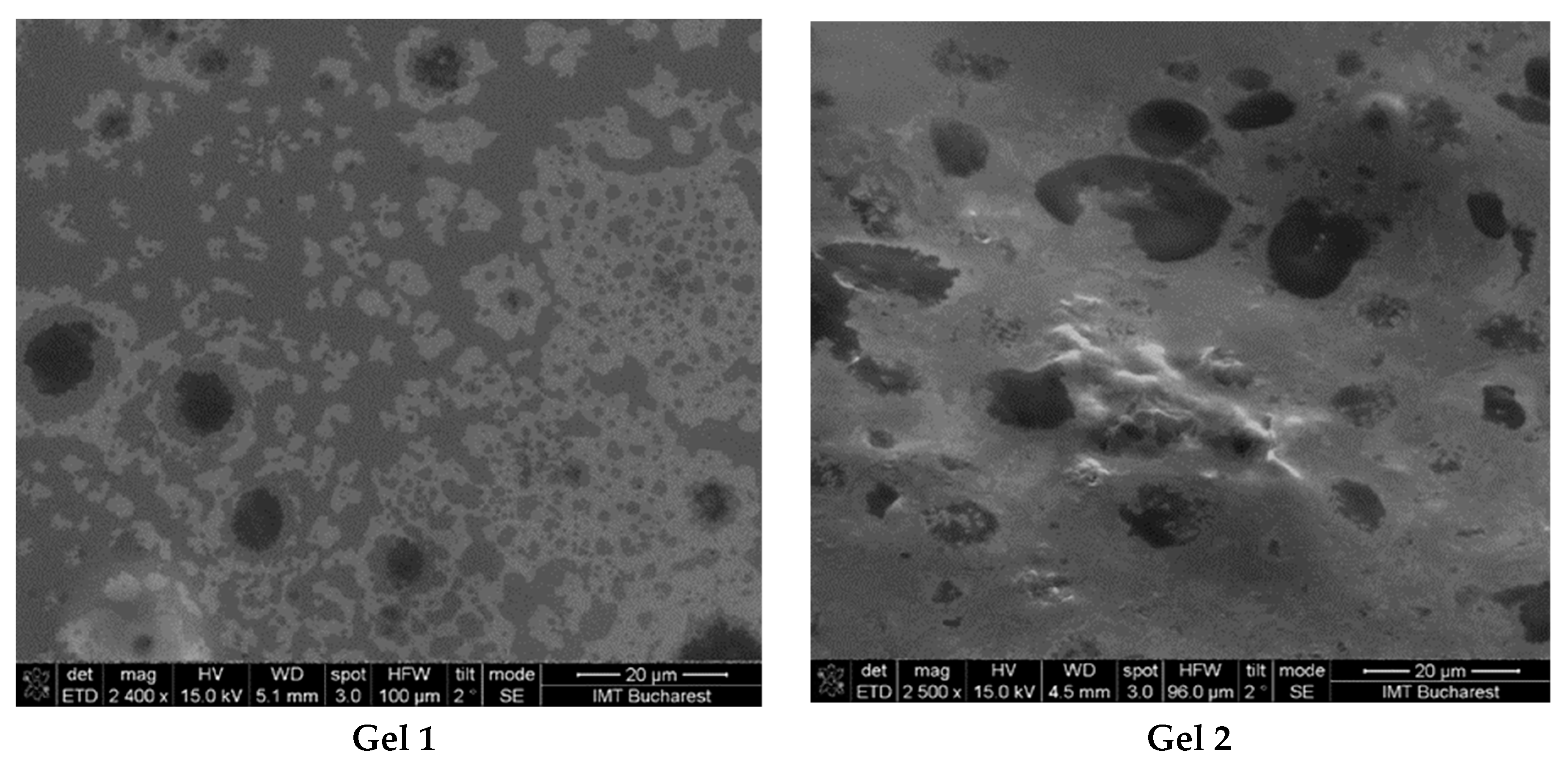

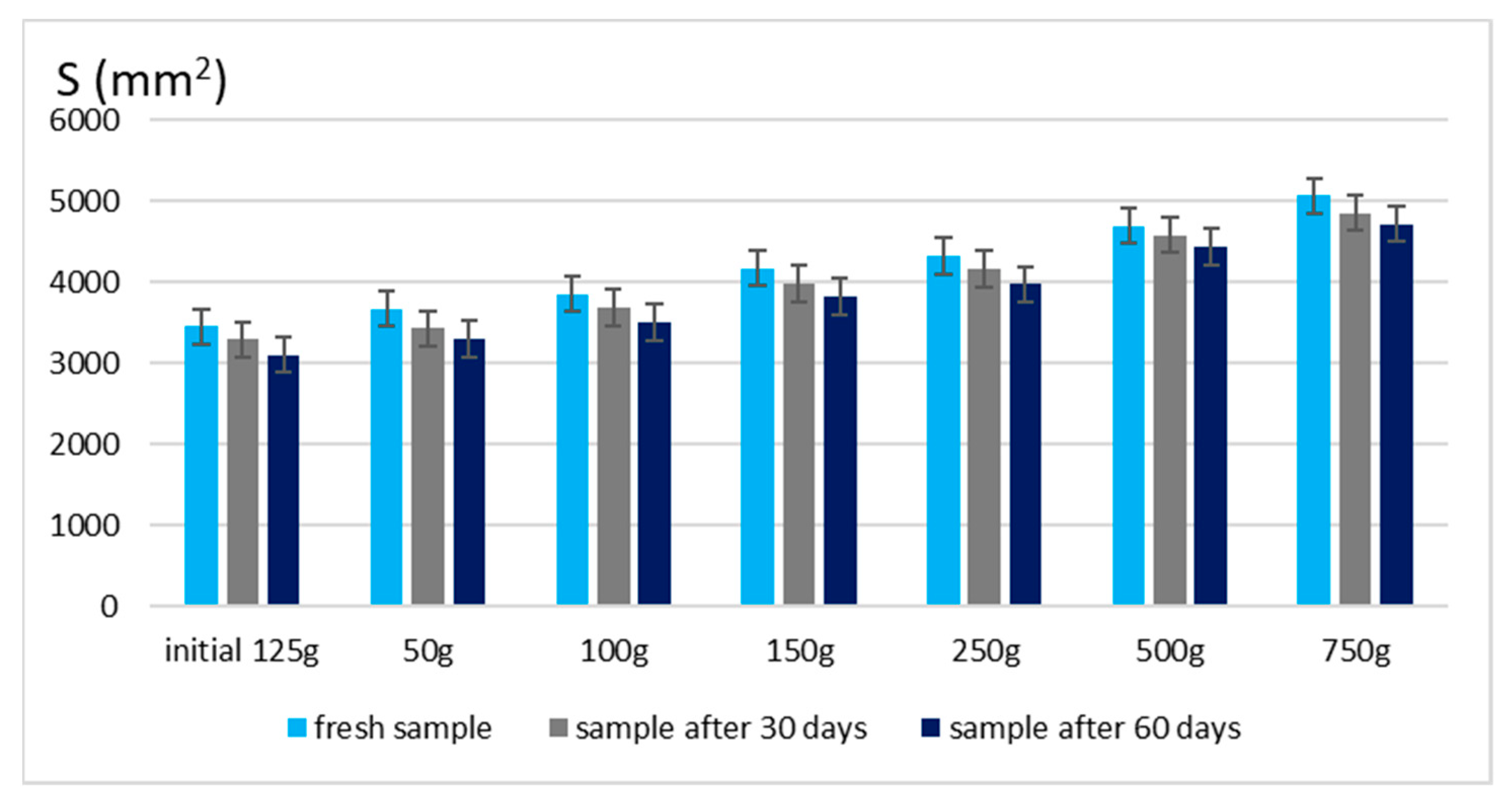

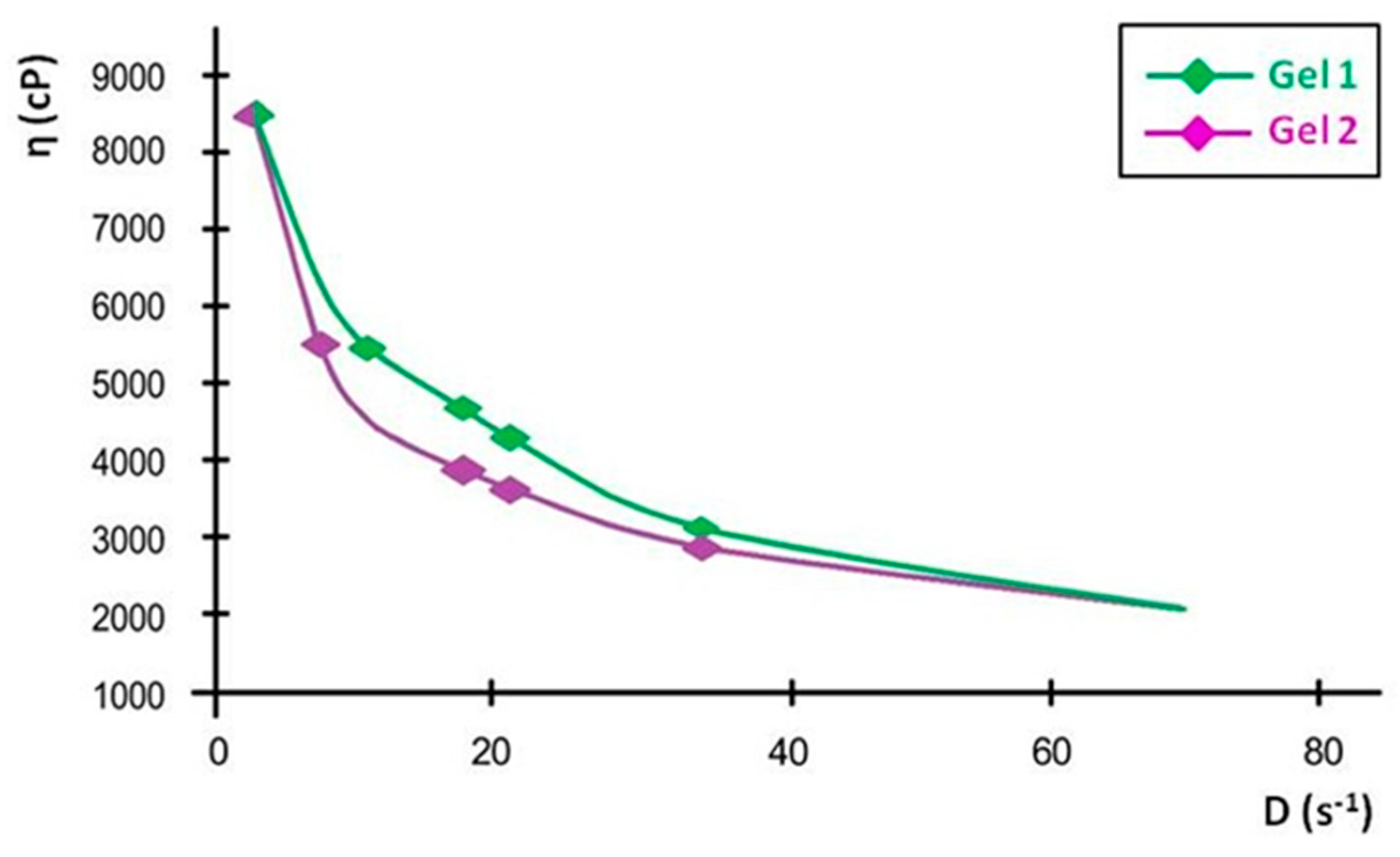

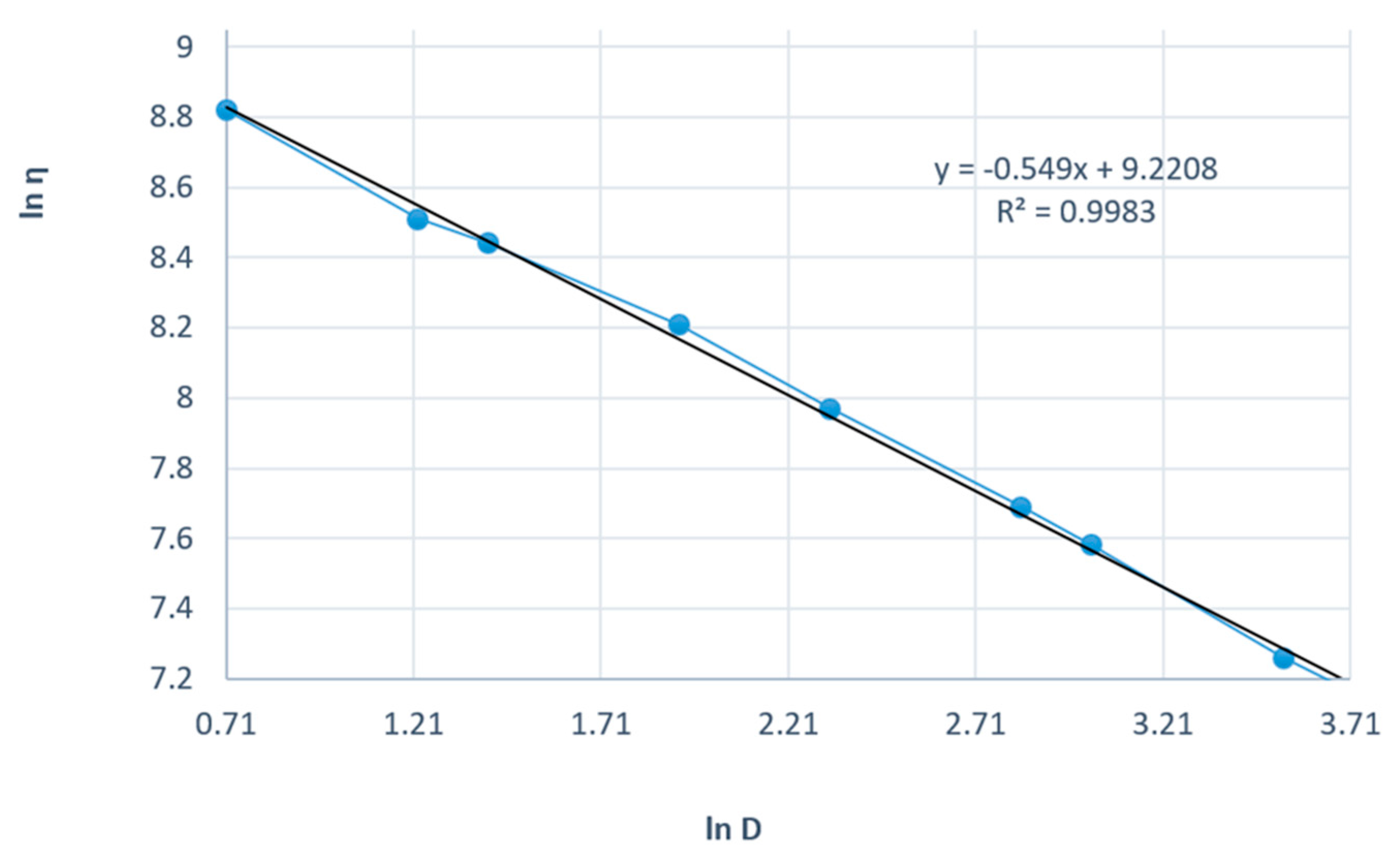
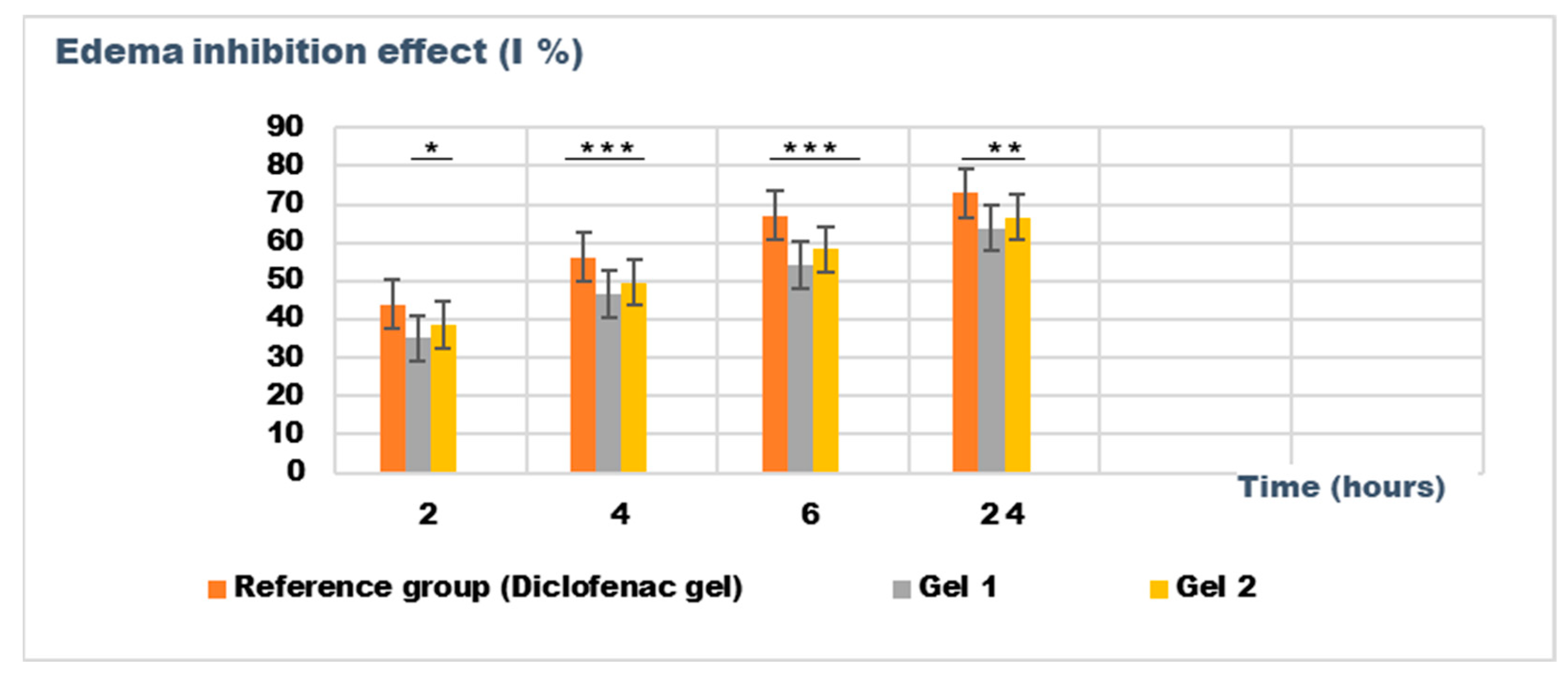
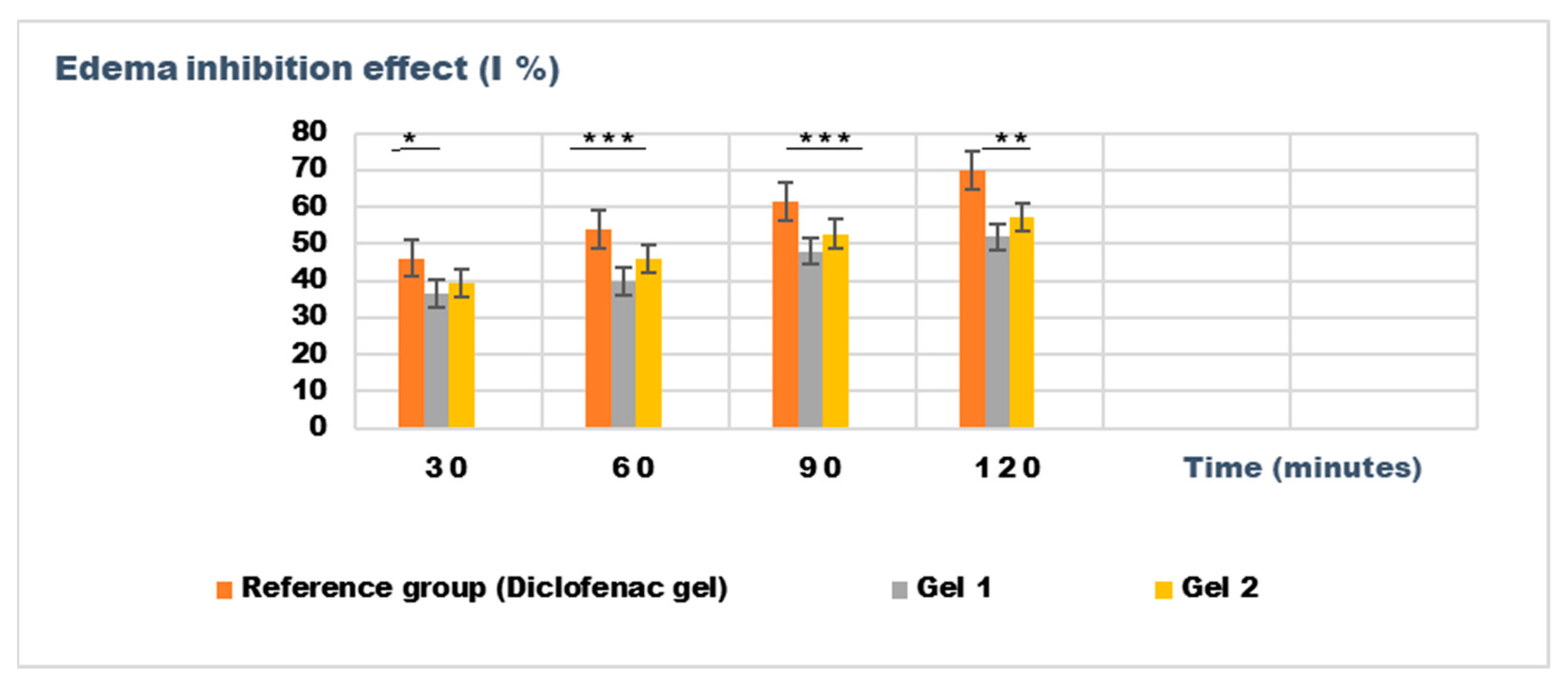


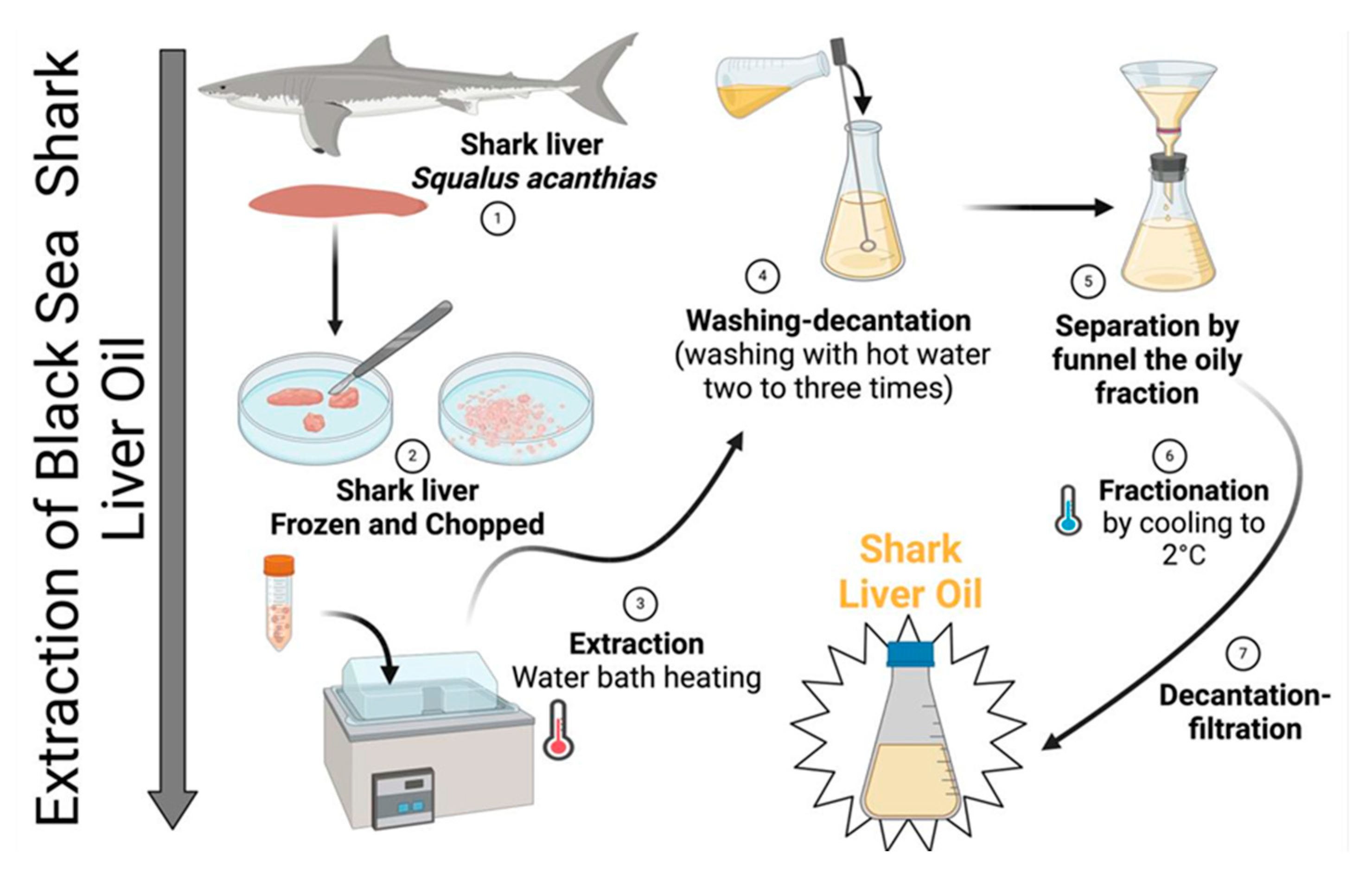
| Parameter | Shark Liver Oil | Borage Oil |
|---|---|---|
| Iodine value (g I2/100 g fatty acids) | 163.22 ± 0.66 | 152.36 ± 0.33 |
| Acid value (mg KOH/g sample) | 3.93 ± 0.33 | 3.68 ± 0.55 |
| Saponification value (mg KOH/g sample) | 185.07 ± 0.25 | 192.18 ± 0.18 |
| Peroxide index (mEq O2/kg) | 2.65 ± 0.55 | 3.84 ± 0.65 |
| Density at 20 °C (g/cm3) | 0.94 ± 0.36 | 0.92 ± 0.25 |
| Refractive index at 20 °C | 1.48 ± 0.57 | 1.48 ± 0.42 |
| Fatty Acid | Shark Liver Oil mg/g ± SD (%) | Borage Oil mg/g ± SD (%) |
|---|---|---|
| C 10: 0 | 0.12 ± 0.23 | 0.36 ± 0.41 |
| C 12: 0 | 0.46 ± 0.13 | 0.82 ± 0.26 |
| C 14: 0 | 1.23 ± 0.45 | 0.93 ± 0.44 |
| C 15: 0 | 0.46 ± 0.16 | ND |
| C 16: 0 | 14.15 ± 1.84 | 15.87 ± 1.22 |
| C 17: 0 | 0.82 ± 0.28 | ND |
| C 18: 0 | 5.75 ± 0.33 | 5.96 ± 0.65 |
| C 20: 0 | 0.87 ± 0.18 | 0.48 ± 0.14 |
| C 22: 0 | 0.41 ± 0.24 | 0.39 ± 0.34 |
| C 24: 0 | 0.26 ± 0.55 | 0.41 ± 0.52 |
| C 26: 0 | 0.08 ± 0.35 | ND |
| C 14: 1 | 0.11 ± 0.33 | 0.31 ± 0.19 |
| C 16: 1 | 4.23 ± 0.52 | 0.82 ± 0.11 |
| C 16: 1ω-7 | 2.92 ± 0.81 | ND |
| C 17: 1 | 0.27 ± 0.18 | ND |
| C 18: 1 | 7.72 ± 0.73 | 13.37 ± 0.28 |
| C 18: 1ω-7 | 3.75 ± 0.33 | ND |
| C 18: 1ω-9 | 2.81 ± 0.74 | ND |
| C 20: 1 | 2.19 ± 0.38 | 0.94 ± 0.63 |
| C 22:1 | 0.37 ± 0.14 | 0.47 ± 0.11 |
| C 24:1 | 0.41 ± 0.12 | 0.36 ± 0.34 |
| C 18: 2ω-6 | 4.48 ± 0.52 | 29.86 ± 1.16 |
| C 18: 3 | 0.25 ± 0.25 | ND |
| C 18: 3ω-6 | 1.92 ± 0.14 | 26.66 ± 0.37 |
| C 20:3 | 2.48 ± 0.24 | 0.40 ± 0.22 |
| C 20: 4ω-6 | 1.68 ± 0.55 | ND |
| C 20: 5ω-3 | 16.68 ± 0.28 | 0.72 ± 0.51 |
| C 22: 5ω-3 | 2.69 ± 0.16 | ND |
| C 22: 6ω-3 | 18.14 ± 0.31 | 0.87 ± 0.14 |
| C 20: 2ω-6 | 0.82 ± 0.44 | ND |
| C 18: 4ω-3 | 1.38 ± 0.62 | ND |
| Σ ω-3 | 38.89 | 1.59 |
| Σ ω-6 | 8.9 | 56.52 |
| ω-3/ω-6 | 4.36 | 0.03 |
| Polyunsaturated fatty acids/Saturated fatty acids | 2.44 | 2.3 |
| Polyunsaturated fatty acids/Monounsaturated fatty acids | 3.92 | 3.48 |
| Characteristics | Gel 1 | Gel 2 |
|---|---|---|
| Initial organoleptic evaluation | appearance: homogeneous; color: yellowish; smell: specific | appearance: homogeneous; color: yellow; smell: specific |
| Organoleptic evaluation after 30 days | maintenance of the original characteristics unchanged | maintenance of the original characteristics unchanged |
| Organoleptic evaluation after 60 days | maintenance of the original characteristics unchanged | maintenance of the original characteristics unchanged |
| pH—initial | 4.7–5.0 | 4.9–5.2 |
| pH—after 30 days | 4.7–5.0 | 4.9–5.2 |
| pH—after 60 days | 5–5.3 | 5.2–5.5 |
| Viscosity—initial | 881.92 ± 1.31 Pa·s | 843.88 ± 2.33 Pa·s |
| Viscosity—after 30 days after 30 days | 875.87 ± 2.63 Pa·s | 831.96 ± 1.72 Pa·s |
| Viscosity—after 60 days | 857.97 ± 1.42 Pa·s | 801.89 ± 1.24 Pa·s |
| Thermal stability initial | good stability without a tendency to separate | good stability without a tendency to separate |
| Thermal stability after 30 days | good stability without a tendency to separate | good stability without a tendency to separate |
| Thermal stability after 60 days | good stability without a tendency to separate | good stability without a tendency to separate |
| Gel/Flow Parameters | Yield Stress (τ0) (Pa) | Consistency Index (K) (Pa⋅sn) | Flow Index (n) | Viscosity at 0.3 rpm (η0.3) (Pa⋅s) Initial | Viscosity at 0.3 rpm (η0.3) (Pa⋅s) After 30 Days |
|---|---|---|---|---|---|
| Gel 1 | 46.233 | 32.738 | 0.290 | 882.700 | 876.200 |
| Gel 2 | 52.366 | 34.114 | 0.280 | 844.600 | 832.600 |
| Emulgel/Rheological Model | Casson | Herschel–Bulkley |
|---|---|---|
| Gel 1 | 0.856 | 0.988 |
| Gel 2 | 0.944 | 0.992 |
| Parameter | K-Consistency Index | n-Flow Index | R-Correlation Coefficient |
|---|---|---|---|
| Test 1 | 9.453 | 0.476 | 0.995 |
| Test 2 | 9.117 | 0.443 | 0.996 |
| Test 3 | 9.721 | 0.501 | 0.995 |
| Average | 9.430 | 0.473 | - |
| DS | 0.303 | 0.029 | - |
| CV(%) | 3.209 | 6.143 | - |
| Parameter | K-Consistency Index | n-Flow Index | R-Correlation Coefficient |
|---|---|---|---|
| Test 1 | 9.221 | 0.451 | 0.998 |
| Test 2 | 9.665 | 0.551 | 0.999 |
| Test 3 | 8.912 | 0.392 | 0.998 |
| Average | 9.266 | 0.465 | - |
| DS | 0.379 | 0.080 | - |
| CV(%) | 4.086 | 17.298 | - |
| Group | ± SD) | ± SD) | ± SD) | ± SD) |
|---|---|---|---|---|
| Control group | 0.228 ± 0.031 ** | 0.274 ± 0.055 ** | 0.340 ± 0.052 * | 0.293 ± 0.036 * |
| Tested group (Gel 1) | 0.148 ± 0.042 * | 0.146 ± 0.061 * | 0.156 ± 0.012 * | 0.106 ± 0.025 ** |
| Tested group (Gel 2) | 0.140 ± 0.012 * | 0.138 ± 0.018 * | 0.142 ± 0.028 * | 0.098 ± 0.016 ** |
| Reference group (Diclofenac gel) | 0.128 ± 0.041 * | 0.120 ± 0.043 * | 0.112 ± 0.028 * | 0.085 ± 0.046 * |
| F (ANOVA) | 1.648 | 3.736 | 1.074 | 4.162 |
| P (ANOVA) | 0.434 | 0.822 | 0.072 | 0.246 |
| Group | ± SD) | ± SD) | ± SD) | ± SD) |
|---|---|---|---|---|
| Control group | 0.208 ± 0.025 ** | 0.226 ± 0.052 ** | 0.254 ± 0.033 * | 0.266 ± 0.055 ** |
| Tested group (Gel 1) | 0.132 ± 0.041 * | 0.136 ± 0.011 * | 0.132 ± 0.046 ** | 0.128 ± 0.021 * |
| Tested group (Gel 2) | 0.126 ± 0.014 * | 0.122 ± 0.011 * | 0.120 ± 0.016 ** | 0.114 ± 0.034 * |
| Reference group (Diclofenac gel) | 0.112 ± 0.034 * | 0.104 ± 0.036 * | 0.098 ± 0.022 * | 0.080 ± 0.044 ** |
| F (ANOVA) | 3.056 | 1.624 | 5.066 | 1.284 |
| P (ANOVA) | 0.608 | 0.418 | 0.224 | 0.104 |
| Group | Initial | 2 Days | 4 Days | 6 Days | 8 Days | 10 Days | 12 Days |
|---|---|---|---|---|---|---|---|
| Control | 108.02 ± 0.25 * | 98.22 ± 0.21 * | 88.81 ± 0.11 * | 76.41 ± 0.33 * | 59.61 ± 0.19 ** | 48.21 ± 0.32 * | 36.42 ± 0.13 * |
| Cicatrizin® | 96.02 ± 0.33 * | 84.21 ± 0.14 * | 68.61 ± 0.75 ** | 52.42 ± 0.21 ** | 46.22 ± 0.85 * | 22.81 ± 0.74 * | 16.81 ± 0.27 * |
| Gel 1 | 104.41 ± 0.25 * | 80.61 ± 0.65 * | 58.22 ± 0.36 * | 42.21 ± 0.24 * | 30.62 ± 0.28 * | 12.42 ± 0.14 * | 0 |
| Gel 2 | 104.02 ± 0.66 * | 78.22 ± 0.55 ** | 54.61 ± 0.15 * | 38.82 ± 0.64 * | 21.81 ± 0.12 * | 2.41 ± 0.48 * | 0 |
| F (ANOVA) | 0.846 | 3.034 | 0.621 | 5.286 | 1.664 | 1.416 | 1.314 |
| P (ANOVA) | 0.442 | 0.068 | 0.056 | 0.014 | 0.208 | 0.254 | 0.302 |
| Components | Gel 1 | Gel 2 |
|---|---|---|
| Carbopol 940 | 2.0 g | 2.0 g |
| Glycerin | 5.0 g | 5.0 g |
| Triethanolamine | q.s. | q.s. |
| Tween 80 | 0.5 g | 0.5 g |
| Shark liver oil | 5.0 g | 2.5 g |
| Borage oil | - | 2.5 g |
| Purified water | until 100 g | until 100 g |
Disclaimer/Publisher’s Note: The statements, opinions and data contained in all publications are solely those of the individual author(s) and contributor(s) and not of MDPI and/or the editor(s). MDPI and/or the editor(s) disclaim responsibility for any injury to people or property resulting from any ideas, methods, instructions or products referred to in the content. |
© 2025 by the authors. Licensee MDPI, Basel, Switzerland. This article is an open access article distributed under the terms and conditions of the Creative Commons Attribution (CC BY) license (https://creativecommons.org/licenses/by/4.0/).
Share and Cite
Neacșu, S.M.; Hîncu, L.; Vlaia, L.L.; Lupuliasa, D.; Scafa-Udriște, A.; Mihai, S.; Olteanu, G.; Grumezescu, A.M.; Ene, R.; Marin, R.C.; et al. Eco-Friendly Extraction and Formulation of Black Sea Shark Liver Oil-Based Emulgel for Anti-Inflammatory and Healing Dermatocosmetic Applications. Gels 2025, 11, 222. https://doi.org/10.3390/gels11040222
Neacșu SM, Hîncu L, Vlaia LL, Lupuliasa D, Scafa-Udriște A, Mihai S, Olteanu G, Grumezescu AM, Ene R, Marin RC, et al. Eco-Friendly Extraction and Formulation of Black Sea Shark Liver Oil-Based Emulgel for Anti-Inflammatory and Healing Dermatocosmetic Applications. Gels. 2025; 11(4):222. https://doi.org/10.3390/gels11040222
Chicago/Turabian StyleNeacșu, Sorinel Marius, Lucian Hîncu, Lavinia Lia Vlaia, Dumitru Lupuliasa, Alexandru Scafa-Udriște, Sebastian Mihai, Gabriel Olteanu, Alexandru Mihai Grumezescu, Răzvan Ene, Ruxandra Cristina Marin, and et al. 2025. "Eco-Friendly Extraction and Formulation of Black Sea Shark Liver Oil-Based Emulgel for Anti-Inflammatory and Healing Dermatocosmetic Applications" Gels 11, no. 4: 222. https://doi.org/10.3390/gels11040222
APA StyleNeacșu, S. M., Hîncu, L., Vlaia, L. L., Lupuliasa, D., Scafa-Udriște, A., Mihai, S., Olteanu, G., Grumezescu, A. M., Ene, R., Marin, R. C., & Mititelu, M. (2025). Eco-Friendly Extraction and Formulation of Black Sea Shark Liver Oil-Based Emulgel for Anti-Inflammatory and Healing Dermatocosmetic Applications. Gels, 11(4), 222. https://doi.org/10.3390/gels11040222









